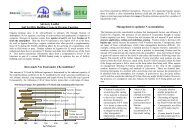A review of leguminous fertility-building crops, with particular ...
A review of leguminous fertility-building crops, with particular ...
A review of leguminous fertility-building crops, with particular ...
Create successful ePaper yourself
Turn your PDF publications into a flip-book with our unique Google optimized e-Paper software.
A <strong>review</strong> <strong>of</strong> <strong>leguminous</strong> <strong>fertility</strong>-<strong>building</strong> <strong>crops</strong>, Defra project OF0316 Executive Summary<br />
• N content <strong>of</strong> grass-only reference crop<br />
• % legume N derived from fixation<br />
• Correction for stubble/root N<br />
• Sward management<br />
Several studies have shown N-fixation and legume yield to be strongly correlated.<br />
Van der Werff et al. (1995) estimated N-fixation in grass/clover pastures on mixed, organic<br />
farms on sandy soils in the Netherlands by assuming values <strong>of</strong>:<br />
• 40 kg N fixed per tonne <strong>of</strong> dry matter for red clover<br />
• 54 kg N fixed per tonne <strong>of</strong> dry matter for white clover.<br />
Vinther & Jensen (2000), for grazed grass/clover pasture in a grass/arable rotation on a<br />
sandy loam in Denmark, assumed that the quantity <strong>of</strong> N fixed per tonne <strong>of</strong> clover shoot dry<br />
weight was:<br />
• 38.6 kg N fixed per tonne <strong>of</strong> dry matter for first and second year mixtures<br />
• 45.0 kg N fixed per tonne <strong>of</strong> dry matter for undersown grass-clover.<br />
These were similar to other values from the literature, cited in the paper: i.e.<br />
• 30-46 kg N fixed per tonne <strong>of</strong> dry matter for white clover<br />
• 24-36 N fixed per tonne <strong>of</strong> dry matter for red clover.<br />
Wheeler et al. (1997), in New Zealand, estimated the amount <strong>of</strong> N fixed as:<br />
• 40 kg N fixed per tonne <strong>of</strong> dry matter for white clover on a high rainfall site<br />
• 46 kg N fixed per tonne <strong>of</strong> dry matter for subterranean clover on a low rainfall site<br />
It has been estimated that lucerne and subterranean clover fixed 22-25 kg N for every tonne<br />
<strong>of</strong> legume dry matter produced.<br />
There have also been more complex, modelling approaches to estimating fixation.<br />
Utilisation <strong>of</strong> N<br />
Nitrogen fixation by the <strong>fertility</strong>-<strong>building</strong> crop is only the first part <strong>of</strong> the process by which<br />
atmospheric N is made available <strong>with</strong>in the rotation. It then has to be released and made<br />
available to the following <strong>crops</strong>. It is necessary to consider the following pools <strong>of</strong> N in the<br />
soil-crop system at the end <strong>of</strong> the <strong>fertility</strong>-<strong>building</strong> stage:<br />
• Soil mineral N in the soil pr<strong>of</strong>ile, the amount depending on history and management <strong>of</strong><br />
the <strong>fertility</strong>-<strong>building</strong> crop. Much <strong>of</strong> this may well have been derived from mineralisation<br />
<strong>of</strong> organic residues during the <strong>fertility</strong>-<strong>building</strong> stage (or from recent manure<br />
applications).<br />
• N in the microbial biomass.<br />
• N in roots and nodules and from rhizodeposition.<br />
• N in leaf litter (e.g., at various stages <strong>of</strong> decay), either from natutral leaf drop or from<br />
cutting and mulching the <strong>fertility</strong>-<strong>building</strong> crop. This may also be from straw residues if<br />
the crop has been harvestsed and removed from the field (e.g. peas/beans).<br />
• N in above ground components, such as stubble and foliage.<br />
• N in manure residues, if manure has been applied recently or the crop has been grazed.<br />
• N in native soil organic matter.<br />
Written by S Cuttle, M Shepherd & G Goodlass Page 8




